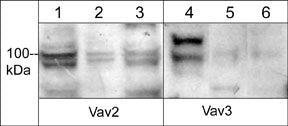Anti-Vav2 Antibody
- SPECIFICATION
- CITATIONS
- PROTOCOLS
- BACKGROUND

| Primary Accession | P52735 |
|---|---|
| Reactivity | Bovine, Chicken |
| Host | Rabbit |
| Clonality | Rabbit Polyclonal |
| Isotype | IgG |
| Calculated MW | 101289 Da |
| Gene ID | 7410 |
|---|---|
| Other Names | VAV2, Guanine nucleotide exchange factor VAV2 |
| Storage | Maintain refrigerated at 2-8°C for up to 6 months. For long term storage store at -20°C in small aliquots to prevent freeze-thaw cycles. |
| Precautions | Anti-Vav2 Antibody is for research use only and not for use in diagnostic or therapeutic procedures. |
| Shipping | Blue Ice |

Thousands of laboratories across the world have published research that depended on the performance of antibodies from Abcepta to advance their research. Check out links to articles that cite our products in major peer-reviewed journals, organized by research category.
info@abcepta.com, and receive a free "I Love Antibodies" mug.
Provided below are standard protocols that you may find useful for product applications.
Background
The Vav family of Rho-guanine nucleotide exchange factors, Vav1, Vav2, and Vav3, have central roles in transducing signals from cell surface receptors, such as integrin, growth factor and immune cell receptors to the cytoskeleton. This role includes receptor-mediated changes in the actin cytoskeleton and cell motility. Vav1 expression is normally restricted to hematopoietic cells, while Vav2 and Vav3 are more widely expressed. All three Vav isoforms have been shown to be abnormally expressed in several types of cancer. Vavs are composed of multiple domains, including a Dbl homology domain, a calponin homology domain, an acidic amino acid region, a pleckstrin homology domain, a cysteine-rich domain, and SH3 and SH2 domains. Vav activity is regulated by the phosphorylation status of several conserved tyrosine residues in the acidic region (In Vav2: Tyr-142, Tyr-159, and Tyr-172). These tyrosine residues are able to participate in autoinhibitory interactions with the Dbl homology domain and this interaction is prevented after phosphorylation of these sites leading to activation of Vav GEF activity.
If you have used an Abcepta product and would like to share how it has performed, please click on the "Submit Review" button and provide the requested information. Our staff will examine and post your review and contact you if needed.
If you have any additional inquiries please email technical services at tech@abcepta.com.













 Foundational characteristics of cancer include proliferation, angiogenesis, migration, evasion of apoptosis, and cellular immortality. Find key markers for these cellular processes and antibodies to detect them.
Foundational characteristics of cancer include proliferation, angiogenesis, migration, evasion of apoptosis, and cellular immortality. Find key markers for these cellular processes and antibodies to detect them. The SUMOplot™ Analysis Program predicts and scores sumoylation sites in your protein. SUMOylation is a post-translational modification involved in various cellular processes, such as nuclear-cytosolic transport, transcriptional regulation, apoptosis, protein stability, response to stress, and progression through the cell cycle.
The SUMOplot™ Analysis Program predicts and scores sumoylation sites in your protein. SUMOylation is a post-translational modification involved in various cellular processes, such as nuclear-cytosolic transport, transcriptional regulation, apoptosis, protein stability, response to stress, and progression through the cell cycle. The Autophagy Receptor Motif Plotter predicts and scores autophagy receptor binding sites in your protein. Identifying proteins connected to this pathway is critical to understanding the role of autophagy in physiological as well as pathological processes such as development, differentiation, neurodegenerative diseases, stress, infection, and cancer.
The Autophagy Receptor Motif Plotter predicts and scores autophagy receptor binding sites in your protein. Identifying proteins connected to this pathway is critical to understanding the role of autophagy in physiological as well as pathological processes such as development, differentiation, neurodegenerative diseases, stress, infection, and cancer.


